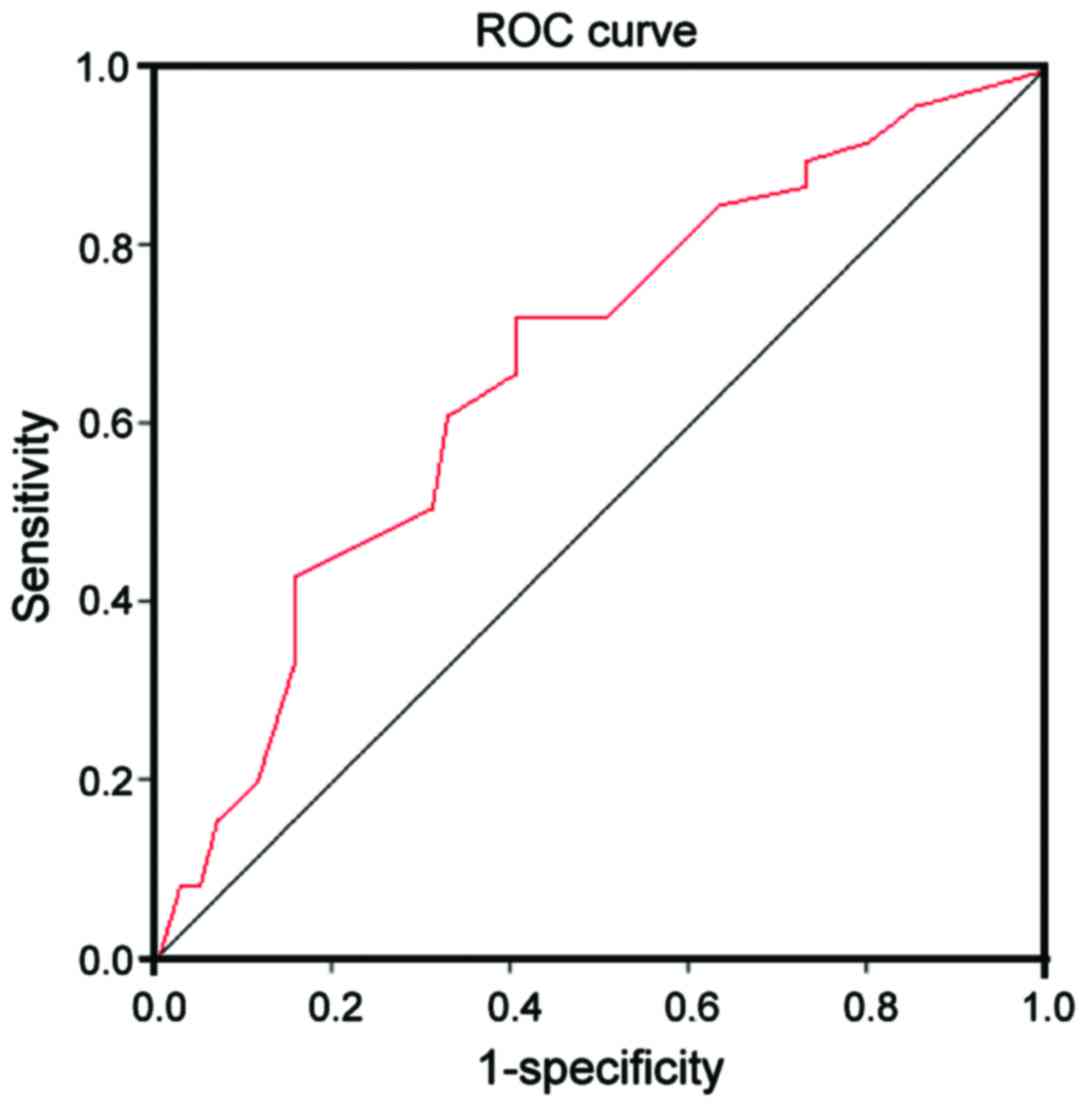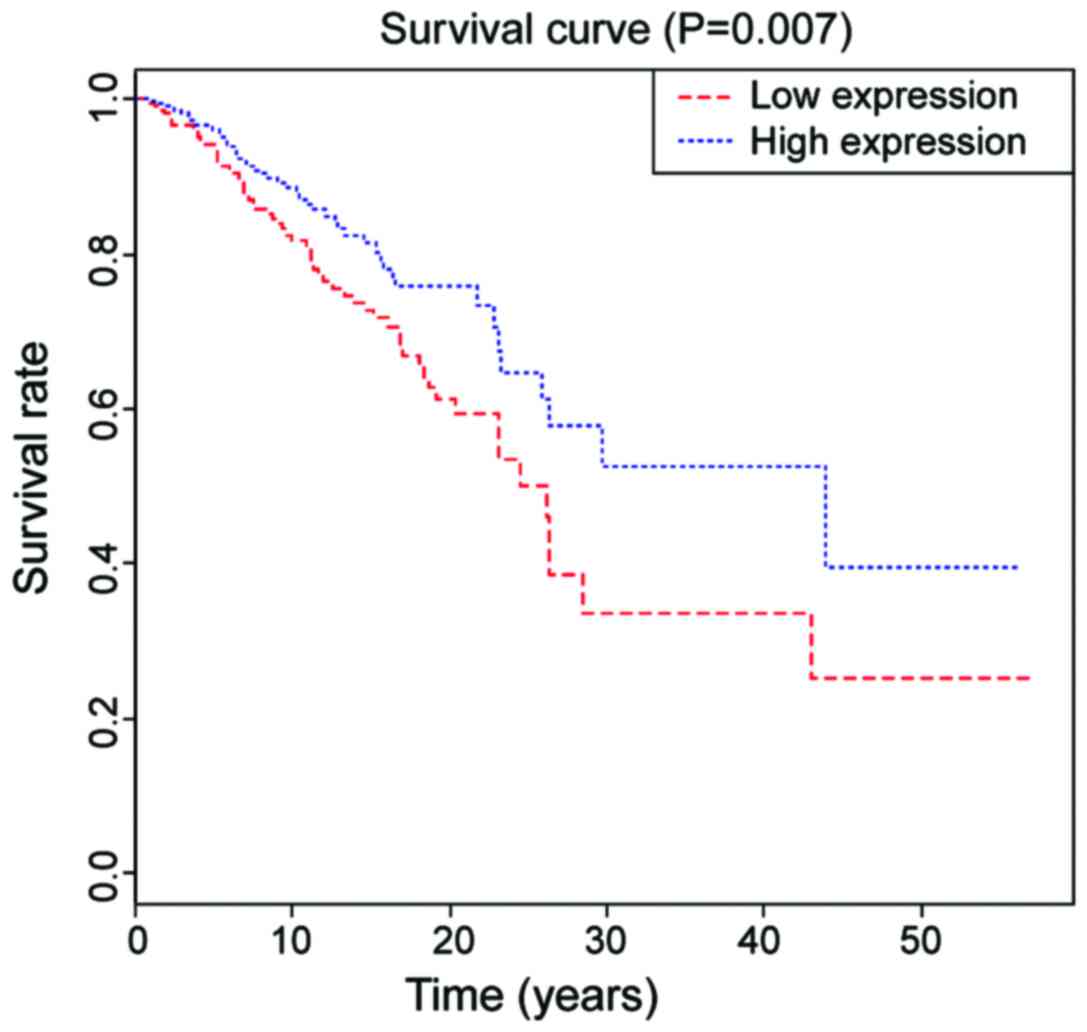|
1
|
Valmasoni M, Pierobon ES, Ruol A, De
Pasqual CA, Zanchettin G, Moletta L, Salvador R, Costantini M and
Merigliano S: Endoscopic tumor length should be reincluded in the
esophageal cancer staging system: Analyses of 662 consecutive
patients. PLoS One. 11:e01530682016. View Article : Google Scholar : PubMed/NCBI
|
|
2
|
Mazzaferri EL and Young RL: Papillary
thyroid carcinoma: A 10 year follow-up report of the impact of
therapy in 576 patients. Am J Med. 70:511–518. 1981. View Article : Google Scholar : PubMed/NCBI
|
|
3
|
Jazdzewski K, Murray EL, Franssila K,
Jarzab B, Schoenberg DR and de la Chapelle A: Common SNP in
pre-miR-146a decreases mature miR expression and predisposes to
papillary thyroid carcinoma. Proc Natl Acad Sci USA. 105:pp.
7269–7274. 2008; View Article : Google Scholar : PubMed/NCBI
|
|
4
|
Huang Y, Prasad M, Lemon WJ, Hampel H,
Wright FA, Kornacker K, LiVolsi V, Frankel W, Kloos RT, Eng C, et
al: Gene expression in papillary thyroid carcinoma reveals highly
consistent profiles. Proc Natl Acad Sci USA. 98:pp. 15044–15049.
2001; View Article : Google Scholar : PubMed/NCBI
|
|
5
|
Hu Y, Wang H, Chen E, Xu Z, Chen B and Lu
G: Candidate microRNAs as biomarkers of thyroid carcinoma: A
systematic review, meta-analysis, and experimental validation.
Cancer Med. 5:2602–2614. 2016. View
Article : Google Scholar : PubMed/NCBI
|
|
6
|
Agrawal N, Akbani R, Aksoy BA, Ally A,
Arachchi H, Asa SL, Auman JT, Balasundaram M, Balu S, Baylin SB, et
al Cancer Genome Atlas Research Network, : Integrated genomic
characterization of papillary thyroid carcinoma. Cell. 159:676–690.
2014. View Article : Google Scholar : PubMed/NCBI
|
|
7
|
Fu XM, Guo W, Li N, Liu HZ, Liu J, Qiu SQ,
Zhang Q, Wang LC, Li F and Li CL: The expression and function of
long noncoding RNA lncRNA-ATB in papillary thyroid cancer. Eur Rev
Med Pharmacol Sci. 21:3239–3246. 2017.PubMed/NCBI
|
|
8
|
Ragazzi M, Ciarrocchi A, Sancisi V,
Gandolfi G, Bisagni A and Piana S: Update on anaplastic thyroid
carcinoma: Morphological, molecular, and genetic features of the
most aggressive thyroid cancer. Int J Endocrinol. 2014:7908342014.
View Article : Google Scholar : PubMed/NCBI
|
|
9
|
Wei WJ, Lu ZW, Wang Y, Zhu YX, Wang YL and
Ji QH: Clinical significance of papillary thyroid cancer risk loci
identified by genome-wide association studies. Cancer Genet.
208:68–75. 2015. View Article : Google Scholar : PubMed/NCBI
|
|
10
|
Liu X, Qu S, Liu R, Sheng C, Shi X, Zhu G,
Murugan AK, Guan H, Yu H, Wang Y, et al: TERT promoter mutations
and their association with BRAF V600E mutation and aggressive
clinicopathological characteristics of thyroid cancer. J Clin
Endocrinol Metab. 99:E1130–E1136. 2014. View Article : Google Scholar : PubMed/NCBI
|
|
11
|
Kunstman JW, Juhlin CC, Goh G, Brown TC,
Stenman A, Healy JM, Rubinstein JC, Choi M, Kiss N, Nelson-Williams
C, et al: Characterization of the mutational landscape of
anaplastic thyroid cancer via whole-exome sequencing. Hum Mol
Genet. 24:2318–2329. 2015. View Article : Google Scholar : PubMed/NCBI
|
|
12
|
Wang L, Mo X, Xu Y, Zuo B, Lei M, Li F,
Jiang S, Deng C and Xiong Y: Molecular characterization and
expression patterns of AMP deaminase1 (AMPD1) in porcine skeletal
muscle. Comp Biochem Physiol B Biochem Mol Biol. 151:159–166. 2008.
View Article : Google Scholar : PubMed/NCBI
|
|
13
|
Tousoulis D, Kioufis S, Siasos G,
Oikonomou E, Zaromitidou M, Maniatis K, Kokkou E, Mazaris S,
Zakynthinos G, Konsola T, et al: The impact of AMPD1 gene
polymorphism on vascular function and inflammation in patients with
coronary artery disease. Int J Cardiol. 172:e516–e518. 2014.
View Article : Google Scholar : PubMed/NCBI
|
|
14
|
Sabina RL, Morisaki T, Clarke P, Eddy R,
Shows TB, Morton CC and Holmes EW: Characterization of the human
and rat myoadenylate deaminase genes. J Biol Chem. 265:9423–9433.
1990.PubMed/NCBI
|
|
15
|
Fischer S, Drenckhahn C, Wolf C, Eschrich
K, Kellermann S, Froster UG and Schober R: Clinical significance
and neuropathology of primary MADD in C34-T and G468-T mutations of
the AMPD1 gene. Clin Neuropathol. 24:77–85. 2005.PubMed/NCBI
|
|
16
|
Loh E, Rebbeck TR, Mahoney PD, DeNofrio D,
Swain JL and Holmes EW: Common variant in AMPD1 gene predicts
improved clinical outcome in patients with heart failure.
Circulation. 99:1422–1425. 1999. View Article : Google Scholar : PubMed/NCBI
|
|
17
|
Li J, Yang T, Zhao T, Liang J and Lin YS:
Clinical outcome of radioiodine therapy in low-intermediate risk
papillary thyroid carcinoma with BRAF(V600E) mutation. Zhongguo Yi
Xue Ke Xue Yuan Xue Bao. 38:346–350. 2016.(In Chinese). PubMed/NCBI
|
|
18
|
Cheng J, Morisaki H, Toyama K, Sugimoto N,
Shintani T, Tandelilin A, Hirase T, Holmes EW and Morisaki T:
AMPD1: A novel therapeutic target for reversing insulin resistance.
BMC Endocr Disord. 14:962014. View Article : Google Scholar : PubMed/NCBI
|
|
19
|
Feng AF, Liu ZH, Zhou SL, Zhao SY, Zhu YX
and Wang HX: Effects of AMPD1 gene C34T polymorphism on cardiac
index, blood pressure and prognosis in patients with cardiovascular
diseases: A meta-analysis. BMC Cardiovasc Disord. 17:1742017.
View Article : Google Scholar : PubMed/NCBI
|
|
20
|
Hay ID, Bergstralh EJ, Goellner JR,
Ebersold JR and Grant CS: Predicting outcome in papillary thyroid
carcinoma: Development of a reliable prognostic scoring system in a
cohort of 1779 patients surgically treated at one institution
during 1940 through 1989. Surgery. 114:1050–1058. 1993.PubMed/NCBI
|











